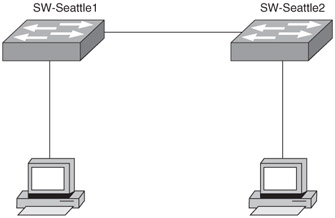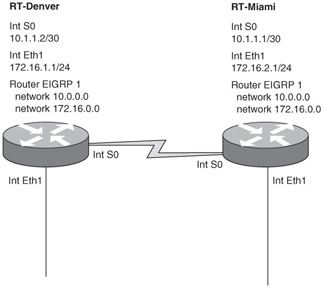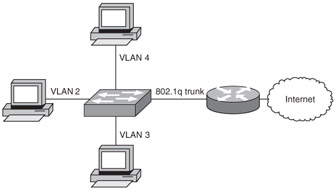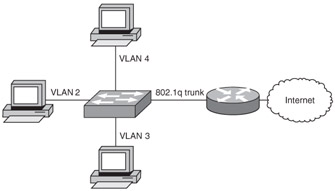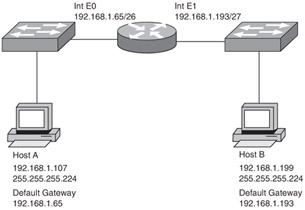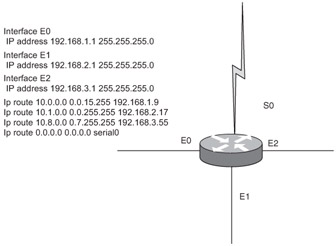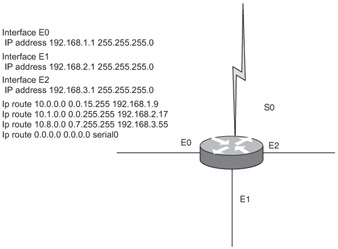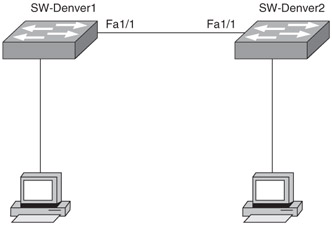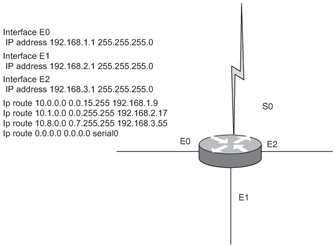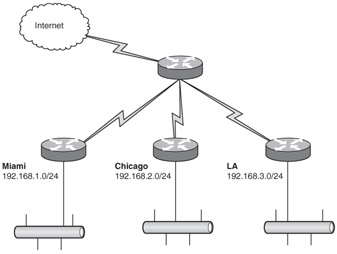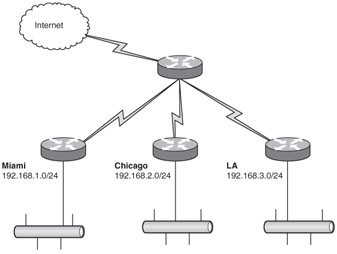CCNA-Practice Test 8
Directions: For each of the following questions, select the choice that best answers the question or completes the statement.
| 1. | What protocol sends redirects to an originating router?
| |
| 2. | What command shows you the IP address of your neighbor device?
| |
| 3. | Look at the following diagram. You have installed the two switches SW-Seattle1 and SW-Seattle2. When you issue the show cdp neighbor command on them, you note that neither switch can see the other one. Which of the following is the most likely cause?
| |
| 4. | Which of the following will correctly add a default route to a router?
| |
| 5. | How is a bridge ID assigned?
| |
| 6. | What does the config mem command do?
| |
| 7. | Look at the following diagram. You have configured the network as shown, yet it has failed to converge. Which of the following is the likely reason?
| |
| 8. | You have been asked to recommend a WAN service for a small rural network. It has 11 offices and needs fully meshed connectivity and at least 768Kbps of throughput. Which of the following is the best option?
| |
| 9. | What does the config net command do?
| |
| 10. | What are the valid hosts for the subnet on which the address 172.16.4.14 255.255.252.0 resides?
| |
| 11. | Look at the following diagram. Suppose you have been given the 192.168.74.0/24 network to use at this site. You need to create subnets for each of the three VLANs. Assuming that you have VLSM available, what is the largest number of host addresses you can have?
| |
| 12. | Look at the following diagram. Suppose you have been given the 192.168.74.0/24 network to use at this site. You need to create subnets for each of the three VLANs. In this case, you cannot use VLSM. What is the largest number of host addresses you can have?
| |
| 13. | What is wrong with the following command?
access-list 10 permit tcp any any eq 23
| |
| 14. | Which of the following pieces of information will you not find in a routing table?
| |
| 15. | Look at the following diagram. You have been asked to troubleshoot a network problem. What is the most likely cause of network connectivity issues here?
| |
| 16. | What will stop network loops from occurring in distance-vector networks in which a downed link is set to infinity?
| |
| 17. | Which one of the following are valid ways for a switch to learn a MAC address?
| |
| 18. | The following commands have been added to a router to allow it to communicate with an existing OSPF network, but it is not working. What is the likely cause?
Router ospf 10 Network 172.16.0.0 255.255.0.0 area 0
| |
| 19. | Which of the following can you use to segment a LAN? (Choose three.)
| |
| 20. | Consider the following entry from a routing table. What does the 110 stand for?
O 10.0.0.0/8 [110/20] via 192.168.10.1, 00:06:37, Ethernet 0
| |
| 21. | Consider the following entry from a routing table. What does the 20 stand for?
O 10.0.0.0/8 [110/20] via 192.168.10.1, 00:06:37, Ethernet 0
| |
| 22. | Which of the following protocols provides logical addressing and routing through an internetwork?
| |
| 23. | Where are EIGRP successor routes stored?
| |
| 24. | You have a single registered Class C address that you must use to address an internetwork. You cannot use NAT, but you can use VLSM. What is the most efficient choice to use for point-to-point serial links?
| |
| 25. | Which of the following subnet masks corresponds with a /18 network?
| |
| 26. | Which of the following wildcard masks corresponds with a /18 network?
| |
| 27. | Look at the following diagram. You have a router with routing configured as illustrated. Suppose a packet destined for 10.0.23.253 enters the router. Which interface will the router send it out?
| |
| 28. | Which of the following routing protocols combines characteristics of both the distance-vector and link-state routing protocols?
| |
| 29. | Which of the following commands allows you to support discontiguous networking with RIPv2 and EIGRP?
| |
| 30. | What is the last available host address for the IP subnet on which 172.20.7.150 255.255.255.192 resides?
| |
| 31. | Look at the following diagram. You have a router with routing configured as illustrated. Suppose a packet destined for 10.0.12.157 enters the router. Which interface will the router send it out?
| |
| 32. | What is the host range of the subnet in which the following IP address resides?
172.16.10.33 255.255.255.224
| |
| 33. | What does EIGRP use to find redundant paths in the internetwork?
| |
| 34. | Look at the following diagram. Suppose you are asked to configure the switch with an IEEE standard trunk link to the router. Which of the following commands should you use? (Choose three.)
| |
| 35. | Where would a router boot from if a configuration register was set to 0x0101?
| |
| 36. | Which of the following are spanning-tree port states? (Choose three.)
| |
| 37. | Suppose a route has an administrative distance of 0. What does this mean?
| |
| 38. | Which of the following is a valid IP extended access list?
| |
| 39. | Which of the following cables should you use to attach a PC COM port to a router to configure it?
| |
| 40. | What is the default administrative distance of RIP?
| |
| 41. | You have a Cisco router and a non-Cisco router connected through a point-to-point serial link. Both routers are configured for HDLC encapsulation, yet they are not able to communicate. What is the likely problem?
| |
| 42. | Look at the following diagram. Which one of the following are possible properties of the link between the two switches, assuming that it is configured correctly?
| |
| 43. | Look at the following diagram. You have a router with routing configured as illustrated. Suppose a packet destined for 192.168.3.171 enters the router. Which interface will the router send it out?
| |
| 44. | What is the purpose of the Spanning Tree Protocol?
| |
| 45. | Which of the following statements regarding EIGRP successor routes are valid? (Choose two.)
| |
| 46. | Which type of Ethernet cable is used to connect a router to an Ethernet switch?
| |
| 47. | Look at the following diagram. Suppose you wish to permit hosts at LA and Chicago to access web sites on the Internet, but not hosts in Miami. Also, you do not want anyone not in Miami to access web sites hosted in Miami. Which of the following lines might you use in an ACL to complete this, assuming the last line of the access list is access-list 110 permit ip any any?
| |
| 48. | Which of the following is a valid standard IP access-list command?
| |
| 49. | Which of the following are benefits of designing OSPF in a hierarchical fashion? (Choose three.)
| |
| 50. | Which of the following layers of the OSI model is responsible for converting data to segments?
| |
| 51. | Where is a successor route stored? (Choose two.)
| |
| 52. | Look at the following diagram. Suppose you do not want anyone not in Miami to access web sites hosted in Miami. You have created the following access list; where should you best apply it and in what direction?
access-list 110 deny tcp any 192.168.0.0 0.0.0.255 eq 80 access-list 110 permit ip any any
| |
| 53. | Which of the following will be the RID of a router?
| |
| 54. | Which statement is true regarding what VTP transparent mode accomplishes?
| |
| 55. | What command should follow this command?
access-list 110 deny tcp any host 1.1.1.1 eq ftp
| |
Answers
| 1. | C Explanation: C. Internet Control Message Protocol (ICMP) redirect messages are used by routers to notify the hosts on the data link that a better route is available for a particular destination. |
| 2. | C Explanation: C. The show CDP neighbors detail command gives you detailed information concerning neighboring devices. |
| 3. | B Explanation: B. In this case, the most likely cause is a cabling problem. Not seeing a CDP neighbor usually indicates a layer 1 or 2 problem (like not using a crossover cable between two switches). |
| 4. | D Explanation: D. The correct syntax for a default route is to create a static route with the destination network and mask as all zeros. |
| 5. | C Explanation: C. The priority and the MAC address are combined to build the bridge ID. |
| 6. | B Explanation: B. The config command can use the keyword terminal (t), memory (mem), or network (net). The difference is where the information originates (terminal from RAM, memory from NVRAM, and network from a TFTP server). |
| 7. | D Explanation: D. The 172.16.0.0 Class B network has been correctly subnetted, and the subnets are used on discontiguous networks. In this case, the automatic summarization must be disabled. |
| 8. | C Explanation: C. HDLC and PPP are encapsulations, not WAN technologies per se. P2P and ISDN links would be cost-prohibitive in a fully meshed topology. Because Frame Relay can provide multiple PVCs on a single physical link, it is the best recommendation. |
| 9. | C Explanation: C. The config command can use the keyword terminal (t), memory (mem), or network (net). The difference is where the information originates (terminal from RAM, memory from NVRAM, and network from a TFTP server). |
| 10. | D Explanation: D. The Class B subnet mask of 255.255.252.0 gives you 64 subnets, each with 1,022 hosts. The host specified in the question is in the second subnet: 256 - 252 4. The valid hosts for the 4.0 subnet are the numbers between the subnets, or 4.1 to 7.254. The broadcast address for the 4.0 subnet is 7.255. |
| 11. | C Explanation: C. With VLSM, you can create one /25 subnet and two /26 subnets. The /25 subnet yields 126 hosts, and each /26 subnet yields 62 hosts. |
| 12. | B Explanation: B. Because you cannot use VLSM, you must create three /26 subnets. Each /26 subnet yields 62 hosts. |
| 13. | C Explanation: C. This access list is a standard access list (number values 1 through 99). Standard access lists can check only the source address. |
| 14. | C Explanation: C. The purpose of a default gateway is to provide an access point that is external to the Cisco router and capable of routing packets destined for remote networks. The command ip default-gateway is used when the router is not routing IP. |
| 15. | A Explanation: A. Host A has a subnet mask of 255.255.255.224 applied to a /26 network. The correct mask would be 255.255.255.192 for a /26. If you answered C, you were close; but if you changed the configuration of E0 to /27, you would still need to change either the IP address or the default gateway on Host A, because with a /27 mask those two addresses would be in separate subnets. |
| 16. | C Explanation: C. The router that has the link fail sends a route poisoning, setting the metric to an unreachable level. In the case of RIP, the router sets the hop count to 16. |
| 17. | A, B Explanation: A, B. Switches can learn MAC addresses through either static configuration or dynamic learning. VTP carries VLAN information, not MAC addresses. |
| 18. | C Explanation: C. The mask is incorrect here; it should be 0.0.255.255. |
| 19. | B, C, D Explanation: B, C, D. Hubs do not segment the network but rather extend the distance a LAN can run. Bridge, switches, and routers are used to segment networks (although at different layers). |
| 20. | A Explanation: A. The 110 is the administrative distance for this route. |
| 21. | B Explanation: B. The 20 is the distance metric for this route. |
| 22. | A Explanation: A. Internet Protocol (IP) is a routed protocol that provides logical addressing and routing through an internetwork‥ |
| 23. | E Explanation: E. The topology table keeps a list of every link in the network. The best links are placed in the routing table and are considered successor routes. Other links to the same remote networks are considered backup routes and called feasible successors. |
| 24. | D Explanation: D. The /30 subnet mask will give you two hosts per subnet, which is perfect for addressing serial links where only two addresses are required. |
| 25. | B Explanation: B. A /18network indicates that the first two octets, and the first two bits of the third octet, are part of the network address. |
| 26. | B Explanation: B. In a /18 network, the last six bits in the third octet, and all bits in the forth octet, are host bits. Setting these bits to ones (wildcard bits) yields the correct wildcard mask. |
| 27. | D Explanation: D. Because this IP address does not fall into any of the ranges specified by the static routes, it will follow the default route and be sent out S0. |
| 28. | C Explanation: C. Enhanced Interior Gateway Routing Protocol (EIGRP) is classified as a hybrid routing protocol. It uses distance-vector-based routing metrics to determine the best path to remote networks. It can converge faster than a traditional distance-vector routing protocol, however, because of the way it employs characteristics of link-state routing protocols. EIGRP maintains a topology table of the network and sends topology change updates when topology changes occur. |
| 29. | D Explanation: D. To allow the use of discontiguous networks, you need to supply the command no auto-summary under the routing protocol configuration on the classful-network boundary router. |
| 30. | B Explanation: B. The subnet mask is 255.255.255.192, so the block size is 64. Based on that block size, the network addresses are 172.20.7.64 and 172.20.7.128. This device is on the 128 network, and that network has a broadcast of 191, so the last host is 190. |
| 31. | A Explanation: A. The static route to 10.0.0.0 0.0.15.255 includes this host. The target IP address is connected on interface E0. |
| 32. | D Explanation: D. The network block size is 256 minus 224, or 32; therefore, the networks start every 32 addresses. The first network is 172.16.10.0, the second is 172.16.10.32, the third is 172.16.10.64, and so on. This host is on the 172.16.10.32 network, and the range is .33 through .62 with the broadcast at .63. |
| 33. | C Explanation: C. You probably chose D, bandwidth and delay of the line, but that option is incorrect. To find redundant paths, EIGRP uses Diffusing Update Algorithm (DUAL). Bandwidth and delay of the line are used to find the best path to a route after DUAL finds all the paths. |
| 34. | A, D, F Explanation: A, D, F. A will be used to select the appropriate interface; you must then specify the mode as trunk and the encapsulation as dot1q (the IEEE standard; ISL is Cisco proprietary). |
| 35. | B Explanation: B. The configuration register is used to tell the router how to load the IOS and configuration. The value 0x0101 tells the router to boot from ROM. |
| 36. | A, C, D Explanation: A, C, D. The five port states are blocking, listening, learning, forwarding, and disabled. |
| 37. | B Explanation: B. Directly connected networks have the highest administrative distance, or trustworthiness rating, which is 0. |
| 38. | D Explanation: D. Extended access lists use the numbers 100 through 199, which eliminates options B and C. To filter on an upper-layer protocol, you must use UDP or TCP in the protocol field, so option A is wrong. |
| 39. | C Explanation: C. A rollover cable is used to attach to the console port of a router to configure it. |
| 40. | C Explanation: C. Routing Information Protocol (RIP) has an AD of 120 by default. |
| 41. | B Explanation: B. Cisco routers run a proprietary High-Level Data Link Control (HDLC) encapsulation on all serial links by default. To get a Cisco router to connect to a non-Cisco router, you need to change that encapsulation to PPP. |
| 42. | B, D Explanation: B, D. Portfast should not be enabled between switches, only between hosts and switches. The link could be a trunk link if it is carrying multiple VLANs. A crossover cable is used to connect two switches. |
| 43. | C Explanation: C. This host is connected on interface E2. |
| 44. | B Explanation: B. Bridges use the spanning-tree algorithm, enabling a learning bridge to dynamically work around loops in a network topology by creating a spanning tree. |
| 45. | A, D Explanation: A, D. Successor routes are routes that are considered the best route (think successful!). Feasible successor routes are backup routes stored in the topology table. |
| 46. | C Explanation: C. A straight-through Ethernet cable is used to connect a host or router to a switch. |
| 47. | A, C Explanation: A, C. A will block access from hosts on the Miami subnet to external web sites, and C will block anyone, regardless of source, from accessing web sites in Miami. |
| 48. | B Explanation: B. Options A and D use access-list numbers that are reserved for extended IP access lists. Option C filters by protocol, which a standard IP access list cannot do. |
| 49. | A, B, C Explanation: A, B, C. OSPF hierarchical design, if done correctly, can help decrease routing protocol overhead as well as speed up convergence time of the network. If a problem occurs, the whole network isn't flooded with information; only routers within the troublesome area are affected. However, a multi-area design is a much more difficult configuration. |
| 50. | D Explanation: D. The Transport layer of the OSI model receives raw data from the Session layer to create segments. The Transport layer divides the data stream into units and encapsulates the information with Transport layer header-specific information. |
| 51. | A, B Explanation: A, B. The successor routes are stored in both the topology table and the neighbor table. Feasible successors are stored in the topology table and are considered backup routes. |
| 52. | D Explanation: D. Although A would work, D is the best place for an access list of this type. |
| 53. | D Explanation: D. By default, the highest IP address of any active interface at the moment of OSPF startup is the RID of the router. However, if a logical interface is configured, then the IP address of the logical interface is the RID of the router. |
| 54. | A Explanation: A. The transparent switch is a stand-alone switch that can be connected to your network for management. It does not add VLAN information to its VLAN database, nor does it share its configured VLAN information. It passes VLAN information received from one trunked port out a different trunked port if configured. |
| 55. | C Explanation: C. You cannot create a deny list without at least one permit. The command access-list 110 permit ip any any (0.0.0.0 255.255.255.255 is the same as the any command) is a wildcard that permits everything not eliminated from a deny test statement. |
